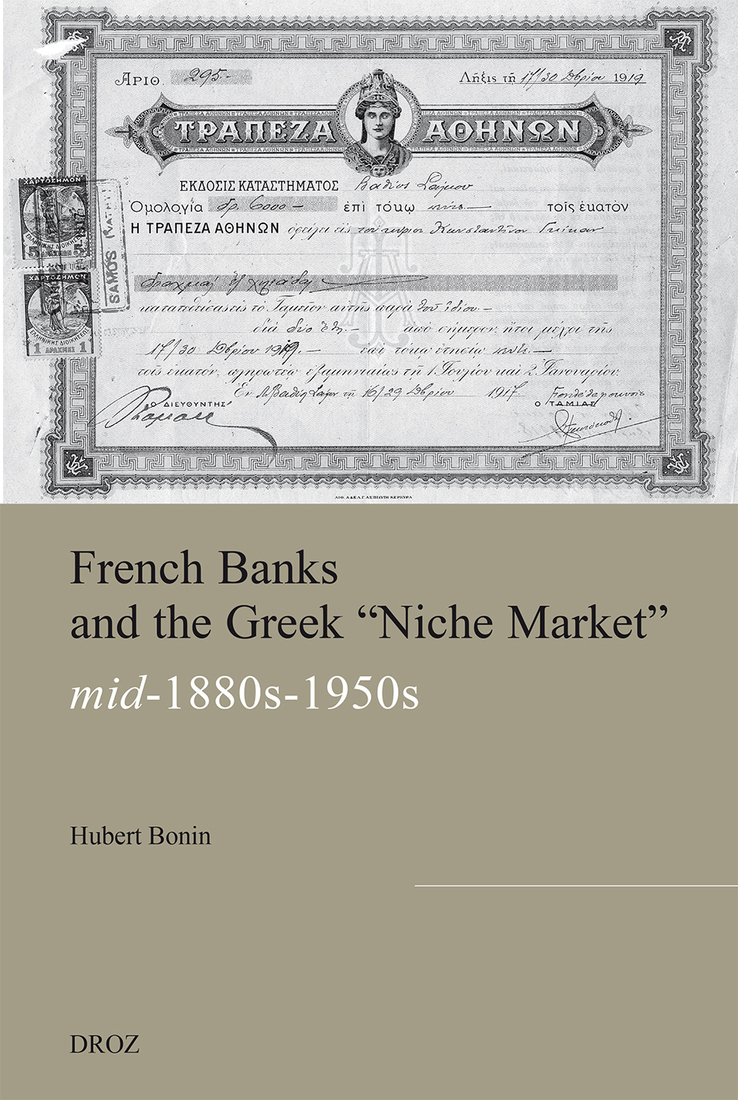TABLE OF CONTENTS
Acknowledgments and Precisions
A Perspective on Archives
Introductory Issues
- French banks in key and emerging markets
- Greece and the north-east Mediterranean area as targets for French banks.
PART I : A RENEWED MEDITERRANEAN SCOPE
Introduction
Chapter 1. European and Mediterranean connections within the emerging second banking revolution (1860s-1890s)
- Emerging connections till the 1860s
- French finance considering a Greek Eldorado?
- A day-to-day banking relationship?
- Prevailing uncertainties
Conclusion
Chapter 2. French banks and Greek finance (c.1870s-1890)
- The first financial experiences (1833-1879)
- French banks and the 1881 issue
- French banks and the 1884 issue
- French banks involved in the 1887 issue
- French banks involved in advances to the Greek Treasury
Conclusion
Chapter 3. Greece as a niche market for investment banking (c.1890s-1914)
- A second offensive in project financing?
- French interests in the future northern Greece
- Financing infrastructure in Greece itself
Conclusion
Chapter 4. A second offensive in capital finance?
- The effects of the 1893 default and of the 1897 defeat
- Rebuilding confidence (1898)
- The 1898 issue of Greek bonds
- A light financial relationship between 1898 and 1910
- A succession of advances and issues (1907-1911)
- Preparing a big issue (1910-1914)
Conclusion
Chapter 5. The robust growth of correspondent banking (c.1890s-1914)
- Nbg well treated in France
- Brokerage for the account of nbg
- Cash accounts management
Conclusion
Chapter 6. Greece within French banks’ strategic scope (1890s-1914). The case of Banque d’Athènes
- Banque d’Athènes before the partnership with Bup
- A sustainable partnership between Banque d’Athènes and Bup
- The rapid growth of Banque d’Athènes
- Bup as a partner of Banque d’Athènes
Conclusion
Chapter 7. Banque de Salonique as a challenge by French banks
- Salonica as a business port-city
- The scramble for Salonica
- The convergence between Levantines and Westerners
Conclusion
The headquarters of Banque de Salonique
Chapter 8. Banque de Salonique as a robust bank (at the turn of the 20th century)
- A moderate growth which accelerated in the 20th century
- A network of branches on two continents
- Banque de Salonique’s banking business and trade
- A diversified bank
Conclusion
Chapter 9. Société générale as Banque de Salonique’s godmother
- Headquarters as a beacon of a mighty bank
- Société générale as Banque de Saloniques partner (from 1907-1908)
- Banque de Salonique refinanced by its sponsors
- Banque de Salonique as Société générale’s bridgehead in the Ottoman Empire?
- Banque de Salonique shaken by the Balkanic Wars
- The Banque de Salonique’s future inquestion (1913-1914)
Conclusion
First Part. Conclusion
PART II : FRANCO-GREEK BANKS CONFRONTED BY GEOPOLITICAL CHALLENGES AND THE GROWTH OF THE AEGEAN (1914-1930)
Introduction
Chapter 10. Banque d’Athènes and Banque de Salonique confronted by World War I
- Dependance upon war events
- The traditional banking operations
- The banks in the war economy
Conclusion
Chapter 11. Banque de Salonique becoming less and less Greek: new sponsor, new business domains
- Société générale withdrawing from Banque de Salonique
- Cfat as the Banque de Salonique’s godfather
- Banque de Salonique as a Turkish commercial bank
- Banque de Salonique’s initial hesitation in Greece
- Banque de Salonique regaining momentum
Conclusion
Chapter 12. Franco-Greek banking co-operation and Banque d’Athènes in the 1920s
- Banque d’Athènes as the Banque de l’union parisienne’s cherished godchild
- The expansion of the second Greek bank
- A Franco-Greek bank without sufficient Franco-Greek business relations
Conclusion
Chapter 13. French banks faced by European competition in Greek financial affairs during the 1920s
- The Franco-Greek banking community and Greek financial transactions
- Was Banque d’Athènes a relay for investment activities in Greece?
Conclusion
Chapter 14. Banque d’Athènes established as the second Greek bank during the 1920s
- The second Greek bank
- A peculiar balance sheet
- A profitable and successful enterprise?
Conclusion
PART III :THE LOST DECADES (1930s-1950s)
Introduction
Chapter 15. Banque d’Athènes and the crisis of the 1930s
- The breakdown of Franco-Greek financial links at the heart of the debt crisis
- The Franco-Greek commercial downturn at the heart of the general slump
- Was Banque de l’union parisienne trapped in its Greek affaires?
- Banque d’Athènes as more of a Greco-American bank
- A Franco-Greek bank or a Greek bank?
- A hardy establishment
Conclusion
Chapter 16. Banks involved in the overall fate of Greece at war
- Banque d’Athènes during the conflict
- Banque de Salonique during the conflict
- A sequel of WWII: the civil war
Conclusion
Chapter 17. The uncertain future of French banking interests in Greece (1945-1953)
- Prevailing uncertainties
- The continuity in the Banque d’Athènes’ management
- The Banque d’Athènes’ resurgence
- The resumption of partnerships and sponsorships
- The Reintegration into the international circuit
- A contrasting balance sheet profile
Conclusion
Chapter 18. Banque de l’union parisienne far from Banque d’Athènes
- Reconsidering the Greek niche strategy
- The merger between Banque d’Athènes and Nbg (1953)
- Abandoning the Greek overseas market
General Conclusion
- Internationalised bankers: Their portofolio of activities and skills.
- Banking outlets in East Mediterranean and the Aegean Sea
- A stop to the niche strategy
- The return of French banks?



